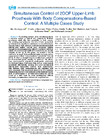Simultaneous Control of 2DOF Upper-Limb Prosthesis With Body Compensations-Based Control: A Multiple Cases Study
Abstract
Controlling several joints simultaneously is a common feature of natural arm movements. Robotic prostheses shall offer this possibility to their wearer. Yet, existing approaches to control a robotic upper-limb prosthesis from myoelectric interfaces do not satisfactorily respond to this need: standard methods provide sequential joint-by-joint motion control only; advanced pattern recognition-based approaches allow the control of a limited subset of synchronized multi-joint movements and remain complex to set up. In this paper, we exploit a control method of an upper-limb prosthesis based on body motion measurement called Compensations Cancellation Control (CCC). It offers a straightforward simultaneous control of the intermediate joints, namely the wrist and the elbow. Four transhumeral amputated participants performed the Refined Rolyan Clothespin Test with an experimental prosthesis alternatively running CCC and conventional joint-by-joint myoelectric control. Task performance, joint motions, body compensations and cognitive load were assessed. This experiment shows that CCC restores simultaneity between prosthetic joints while maintaining the level of performance of conventional myoelectric control (used on a daily basis by three participants), without increasing compensatory motions nor cognitive load. Show more
Permanent link
https://doi.org/10.3929/ethz-b-000558168Publication status
publishedExternal links
Journal / series
IEEE Transactions on Neural Systems and Rehabilitation EngineeringVolume
Pages / Article No.
Publisher
IEEESubject
Prosthesis control; body compensations; physical human–robot interfaceOrganisational unit
02620 - Inst. f. Robotik u. Intelligente Systeme / Inst. Robotics and Intelligent Systems
More
Show all metadata
ETH Bibliography
yes
Altmetrics





